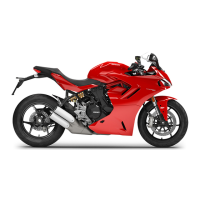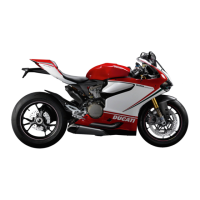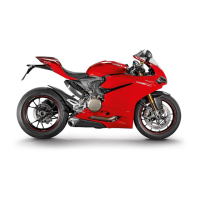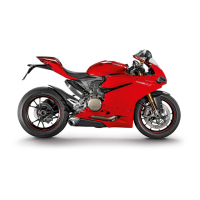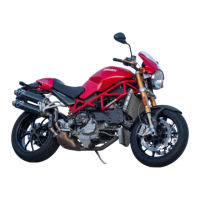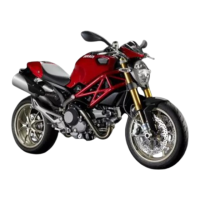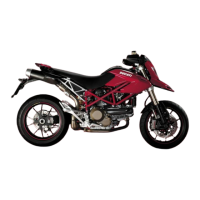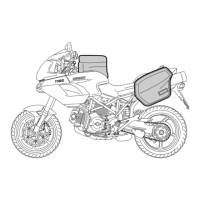Do you have a question about the Ducati Supersport S and is the answer not in the manual?
Welcome and essential advice for safe motorcycle riding and ownership.
Critical operations for rider safety and maintaining motorcycle performance.
Instructions for safely adding fuel, including warnings about flammability.
Description of the motorcycle's dashboard and its various indicator lights.
Explanation of the meaning of DTC and ABS indicator lights.
Visual guide to the instrument panel's numbered components.
Explanation of selectable riding and power delivery modes.
Details on the DTC system and its intervention levels.
Explanation of the ABS system and its functions.
Description of the DQS system for clutchless gear shifting.
Identifies and describes the purpose of various buttons on the motorcycle.
How the instrument panel initializes and displays information upon key-on.
Lists all data shown on the main instrument panel screen.
Procedure to access and use the main settings menu.
Lists primary information displayed on the standard instrument panel screen.
Lists user-modifiable settings accessible via the Setting Menu.
How vehicle speed is shown on the panel and unit settings.
How the current gear or neutral position is displayed.
How the fuel level and low fuel warning light are displayed.
How to choose between SPORT, TOURING, and URBAN riding modes.
Lists parameters like ENGINE, DTC, ABS, DQS configurable within each mode.
Step-by-step instructions to switch between available riding modes.
How DTC activation and status are shown on the instrument panel.
Table showing recommended DTC intervention levels for different riding modes.
Guidance on choosing the correct DTC level based on conditions.
How ABS activation status is shown on the instrument panel.
Advice on proper braking techniques under various riding conditions.
How the ABS system works and its operational limitations.
Table of recommended ABS settings for different riding modes.
Guidance on choosing the right ABS level based on experience and conditions.
How the DQS system status (enabled, disabled, fault) is shown.
Explanation of how the DQS allows clutchless up and down shifting.
How the total distance traveled is shown on the odometer.
Functionality and reset procedure for Trip Meter 1.
Functionality and reset procedure for Trip Meter 2.
How to set and view the current time on the instrument panel.
How to activate the lap timing functionality.
Details the process of recording lap times using the timer.
How average fuel usage is calculated and displayed.
Display of engine coolant temperature in selected units.
How real-time fuel consumption is shown on the panel.
How average speed is calculated and displayed.
Introduction to the Ducati Multimedia System (DMS).
Display of Bluetooth status and connected devices on the panel.
Managing incoming calls and recalling numbers via the system.
How to activate and use the music player function.
How to adjust volume and skip tracks using player controls.
How the motorcycle indicates it is due for scheduled service.
General procedure for customizing individual riding modes.
How to activate or change the motorcycle's PIN code.
Step-by-step guide to setting a new PIN code.
How to change an existing PIN code.
Displays engine RPM numerically for improved accuracy.
Recalibrating system for new tires or sprocket ratios.
Steps for calibrating system after tire or sprocket changes.
Procedure for connecting Bluetooth devices to the motorcycle.
How the engine electronic block (immobilizer) system works.
Information about the keys and their role in the immobilizer system.
Procedure to restore operation using PIN after key malfunction.
Identifies the location and function of key motorcycle controls.
Maintenance tasks performed by dealers based on mileage/time.
Detailed list of dealer maintenance tasks and intervals.
Continued list of dealer maintenance tasks and intervals.
Further dealer maintenance tasks and intervals.
Welcome and essential advice for safe motorcycle riding and ownership.
Critical operations for rider safety and maintaining motorcycle performance.
Instructions for safely adding fuel, including warnings about flammability.
Description of the motorcycle's dashboard and its various indicator lights.
Explanation of the meaning of DTC and ABS indicator lights.
Visual guide to the instrument panel's numbered components.
Explanation of selectable riding and power delivery modes.
Details on the DTC system and its intervention levels.
Explanation of the ABS system and its functions.
Description of the DQS system for clutchless gear shifting.
Identifies and describes the purpose of various buttons on the motorcycle.
How the instrument panel initializes and displays information upon key-on.
Lists all data shown on the main instrument panel screen.
Procedure to access and use the main settings menu.
Lists primary information displayed on the standard instrument panel screen.
Lists user-modifiable settings accessible via the Setting Menu.
How vehicle speed is shown on the panel and unit settings.
How the current gear or neutral position is displayed.
How the fuel level and low fuel warning light are displayed.
How to choose between SPORT, TOURING, and URBAN riding modes.
Lists parameters like ENGINE, DTC, ABS, DQS configurable within each mode.
Step-by-step instructions to switch between available riding modes.
How DTC activation and status are shown on the instrument panel.
Table showing recommended DTC intervention levels for different riding modes.
Guidance on choosing the correct DTC level based on conditions.
How ABS activation status is shown on the instrument panel.
Advice on proper braking techniques under various riding conditions.
How the ABS system works and its operational limitations.
Table of recommended ABS settings for different riding modes.
Guidance on choosing the right ABS level based on experience and conditions.
How the DQS system status (enabled, disabled, fault) is shown.
Explanation of how the DQS allows clutchless up and down shifting.
How the total distance traveled is shown on the odometer.
Functionality and reset procedure for Trip Meter 1.
Functionality and reset procedure for Trip Meter 2.
How to set and view the current time on the instrument panel.
How to activate the lap timing functionality.
Details the process of recording lap times using the timer.
How average fuel usage is calculated and displayed.
Display of engine coolant temperature in selected units.
How real-time fuel consumption is shown on the panel.
How average speed is calculated and displayed.
Introduction to the Ducati Multimedia System (DMS).
Display of Bluetooth status and connected devices on the panel.
Managing incoming calls and recalling numbers via the system.
How to activate and use the music player function.
How to adjust volume and skip tracks using player controls.
How the motorcycle indicates it is due for scheduled service.
General procedure for customizing individual riding modes.
How to activate or change the motorcycle's PIN code.
Step-by-step guide to setting a new PIN code.
How to change an existing PIN code.
Displays engine RPM numerically for improved accuracy.
Recalibrating system for new tires or sprocket ratios.
Steps for calibrating system after tire or sprocket changes.
Procedure for connecting Bluetooth devices to the motorcycle.
How the engine electronic block (immobilizer) system works.
Information about the keys and their role in the immobilizer system.
Procedure to restore operation using PIN after key malfunction.
Identifies the location and function of key motorcycle controls.
Maintenance tasks performed by dealers based on mileage/time.
Detailed list of dealer maintenance tasks and intervals.
Continued list of dealer maintenance tasks and intervals.
Further dealer maintenance tasks and intervals.
| Displacement | 937 cc |
|---|---|
| Power | 110 hp (81 kW) @ 9, 000 rpm |
| Torque | 93 Nm (69 lb-ft) @ 6, 500 rpm |
| Transmission | 6-speed |
| Frame | Tubular steel Trellis frame |
| Wet Weight | 210 kg (463 lb) |
| Seat Height | 810 mm (31.9 in) |
| Engine Type | Ducati Testastretta 11°, L-twin cylinder, 4 valves per cylinder, Desmodromic distribution, liquid cooled |
| Rear Suspension | Fully adjustable Öhlins monoshock |
| Rear Brake | 245 mm disc, 2-piston caliper with ABS |
| Fuel Tank Capacity | 16 liters (4.2 gallons) |

